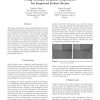Free Online Productivity Tools
i2Speak
i2Symbol
i2OCR
iTex2Img
iWeb2Print
iWeb2Shot
i2Type
iPdf2Split
iPdf2Merge
i2Bopomofo
i2Arabic
i2Style
i2Image
i2PDF
iLatex2Rtf
Sci2ools
ICRA
2002
IEEE
2002
IEEE
Using Multiple Disparity Hypotheses for Improved Indoor Stereo
This paper describes the design and implementation of an algorithm for improving the performance of stereo vision in environments presenting repetitive patterns or regions with relatively weak texture. The proposed algorithm makes use of the common assumption that the disparities corresponding to continuous surfaces in the world vary smoothly; we are using this assumption to alleviate the correspondence problem for pixels that cannot be reliably matched by the stereo algorithm. Our approach can be described as a reliability based filtering of the disparity image followed by a recursive propagation step. It can be applied to the output of almost any “standard” stereo algorithm with minimal modifications, and is computationally efficient.
Related Content
| Added | 15 Jul 2010 |
| Updated | 15 Jul 2010 |
| Type | Conference |
| Year | 2002 |
| Where | ICRA |
| Authors | Cristian Dima, Simon Lacroix |
Comments (0)

